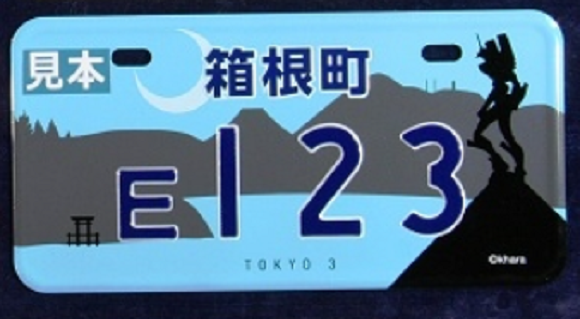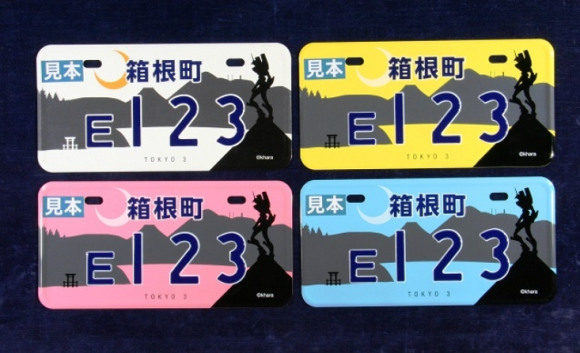
The very first time she came over to the swinging bachelor pad/pitiful bunker I used to live in back when we were dating, my wife immediately noticed that the one and only interior decoration I had was a California license plate mounted on the wall. To me, the blue on white design is immediately nostalgic and reassuring.
In Japan, though, ordinarily the only thing that differentiates plates issued in different parts of the country are the kanji characters written across their tops, so they don’t provide quite the same immediate visual shorthand of local pride. Unless you happen to live in the city of Hakone, where motorists can show their love of their hometown and giant robot anime all at once with new Evangelion license plates.
The vast majority of modern-day anime is set in Tokyo, which is understandable seeing as it’s the country’s political, financial, and entertainment capital. Still, the rest of Japan can feel a little left out once in a while.
Take Kanagawa Prefecture, Tokyo’s neighbor to the south, for example. With over nine million people, it’s the second-most populated administrative district in Japan, but rarely shows up in animated form (a few scenes in the classic Macross notwithstanding).
But while the frequency of Kanagawa’s anime appearances is undeniably low, almost the entirety of Evangelion, the biggest Japanese animation biggest hit of this generation, takes place there.
This may come as a surprise for some viewers, as while Evangelion’s dialogue is 30 percent obfuscating religious references, 30 percent complicated pseudo-science, and 30 percent rambling sexual frustration, the remaining 10 percent clearly has the characters saying they live someplace called Tokyo 3.
A closer look, though, reveals some discrepancies between Tokyo 3 and Japan’s real-life capital. There are two things present in the anime’s setting that are absent from the actual Tokyo: the numerical accoutrements and the surrounding mountains.
That topographical difference is because the location of Evangelion’s Tokyo 3 corresponds with the city of Hakone, in Kanagawa Prefecture.
Hakone is already a pretty big tourist draw, thanks to its proximity to Mt. Fuji, numerous hot springs, and beautiful fields of pampas grass, making it a popular vacation spot for families and couples. In recent years, the local tourism association has drawn in anime fans, too, by playing up the town’s connection to the anime with Evangelion-themed sightseeing maps, vending machines, and souvenir shops (plus cakes, the alpha and the omega of tourism in Japan).
Hakone’s newest Eva-inspired move, though, is for locals. Starting on March 25, owners of motorized bicycles, scooters, and microcars registered in the city can apply for Evangelion license plates.
Each of the four differently colored plates features the series’ titular giant robot in profile, with Hakone landmarks such as Hakone Shrine, Lake Ashinoko, and Mt. Fuji in the background. There’s also a crescent moon, which has no particular connection to Evangelion or Hakone, but is simply there because it looks awesome.
Availability is limited to 390 plates, but given that only 769 vehicles currently registered in Hakone fit the criteria, there should be enough to go around. Interested parties can submit their application at the Hakone Tax Bureau, which unfortunately doesn’t yet sell “My other car is unit 01” bumper stickers.
Source: Anime! Anime!
Top image: Anime! Anime!


 Tokyo’s beautiful new license plates are based on one of Japan’s most famous woodblock paintings
Tokyo’s beautiful new license plates are based on one of Japan’s most famous woodblock paintings Cherry blossoms are going to bloom on Tokyo’s new license plates
Cherry blossoms are going to bloom on Tokyo’s new license plates New stylish Japanese license plates lets people show off prefecture pride on the move
New stylish Japanese license plates lets people show off prefecture pride on the move Get ready for yuru-kyara car plates! Japan to lift ban on colourful regional license plates
Get ready for yuru-kyara car plates! Japan to lift ban on colourful regional license plates Blood-red Evangelion hot spring bath to open in Japan for fun, relaxing terror
Blood-red Evangelion hot spring bath to open in Japan for fun, relaxing terror Harajuku’s new permanent Tamagotchi shop is filled with cuteness and a surprising lack of poop
Harajuku’s new permanent Tamagotchi shop is filled with cuteness and a surprising lack of poop Cappuccino Ramen becomes super popular in Japan, but is it worth the hype?
Cappuccino Ramen becomes super popular in Japan, but is it worth the hype? Starbucks Japan ready to get Year of the Horse started with adorable drinkware and plushies【Pics】
Starbucks Japan ready to get Year of the Horse started with adorable drinkware and plushies【Pics】 Japanese thug wear from Birth Japan perfect for those breaking bad next year
Japanese thug wear from Birth Japan perfect for those breaking bad next year Brand-new Pokémon park opens in Japan with larger-than-life-size Lapras【Photos】
Brand-new Pokémon park opens in Japan with larger-than-life-size Lapras【Photos】 The town with Japan’s best castle also has one of Japan’s best breakfasts. Here’s where to eat it
The town with Japan’s best castle also has one of Japan’s best breakfasts. Here’s where to eat it Pizza Hut Japan’s hot lucky bags are perfect for a New Year’s pizza party
Pizza Hut Japan’s hot lucky bags are perfect for a New Year’s pizza party The 5 best Japanese bento to buy at Kyoto Station
The 5 best Japanese bento to buy at Kyoto Station 7-Eleven Japan’s ramen-cooking robot whipped us up a bowl of noodles【Taste test】
7-Eleven Japan’s ramen-cooking robot whipped us up a bowl of noodles【Taste test】 Survival horror manga “Holy Holy” delayed out of respect for Korean cruise ship accident
Survival horror manga “Holy Holy” delayed out of respect for Korean cruise ship accident Lacquerware supplier to emperor of Japan and Pokémon team up for new tableware
Lacquerware supplier to emperor of Japan and Pokémon team up for new tableware Cyberpunk anime meets traditional culture in Ghost in the Shell gold leaf Japanese changing screens
Cyberpunk anime meets traditional culture in Ghost in the Shell gold leaf Japanese changing screens 7 great places to see Mt. Fuji from without having to climb it
7 great places to see Mt. Fuji from without having to climb it Japan may add Japanese language proficiency, lifestyle classes to permanent foreign resident requirements
Japan may add Japanese language proficiency, lifestyle classes to permanent foreign resident requirements Hello Kitty Choco Egg figures are an adorable trip through three periods of Japanese pop culture【Pics】
Hello Kitty Choco Egg figures are an adorable trip through three periods of Japanese pop culture【Pics】 Japan’s otoshidama tradition of giving kids money at New Year’s gets a social welfare upgrade
Japan’s otoshidama tradition of giving kids money at New Year’s gets a social welfare upgrade Starbucks Japan releases new zodiac chilled cup drink for 2026
Starbucks Japan releases new zodiac chilled cup drink for 2026 Can a dirty butthole make you filthy rich in Japan? We’re starting a New Year’s lottery experiment
Can a dirty butthole make you filthy rich in Japan? We’re starting a New Year’s lottery experiment 7-Eleven Japan starts new temporary luggage storage service in over 300 branches
7-Eleven Japan starts new temporary luggage storage service in over 300 branches Disillusionment at Tsukiji’s tourist-target prices led us to a great ramen restaurant in Tokyo
Disillusionment at Tsukiji’s tourist-target prices led us to a great ramen restaurant in Tokyo Starbucks teams up with 166-year-old Kyoto doll maker for Year of the Horse decorations【Photos】
Starbucks teams up with 166-year-old Kyoto doll maker for Year of the Horse decorations【Photos】 Tokyo considering law requiring more trash cans following litter increase in heavily touristed area
Tokyo considering law requiring more trash cans following litter increase in heavily touristed area Tokyo’s Tsukiji sushi neighborhood asks tour groups to stay away for the rest of the month
Tokyo’s Tsukiji sushi neighborhood asks tour groups to stay away for the rest of the month Nintendo’s Kirby now delivering orders at Kura Sushi restaurants, but not in Japan
Nintendo’s Kirby now delivering orders at Kura Sushi restaurants, but not in Japan Tokyo event lets you travel back in time, for free, to celebrate 100 years since Showa era start
Tokyo event lets you travel back in time, for free, to celebrate 100 years since Showa era start Sanrio theme park in Japan announces plans to expand into a Sanrio resort
Sanrio theme park in Japan announces plans to expand into a Sanrio resort Stamina-destroying “Paralysis Noodles” are Tokyo’s newest over-the-top ramen innovation
Stamina-destroying “Paralysis Noodles” are Tokyo’s newest over-the-top ramen innovation Survey asks foreign tourists what bothered them in Japan, more than half gave same answer
Survey asks foreign tourists what bothered them in Japan, more than half gave same answer Japan’s human washing machines will go on sale to general public, demos to be held in Tokyo
Japan’s human washing machines will go on sale to general public, demos to be held in Tokyo Japan’s deadliest food claims more victims, but why do people keep eating it for New Year’s?
Japan’s deadliest food claims more victims, but why do people keep eating it for New Year’s? We deeply regret going into this tunnel on our walk in the mountains of Japan
We deeply regret going into this tunnel on our walk in the mountains of Japan Studio Ghibli releases Kodama forest spirits from Princess Mononoke to light up your home
Studio Ghibli releases Kodama forest spirits from Princess Mononoke to light up your home Major Japanese hotel chain says reservations via overseas booking sites may not be valid
Major Japanese hotel chain says reservations via overseas booking sites may not be valid Put sesame oil in your coffee? Japanese maker says it’s the best way to start your day【Taste test】
Put sesame oil in your coffee? Japanese maker says it’s the best way to start your day【Taste test】 No more using real katana for tourism activities, Japan’s National Police Agency says
No more using real katana for tourism activities, Japan’s National Police Agency says Starbucks Japan reveals new sakura drinkware collection, inspired by evening cherry blossoms
Starbucks Japan reveals new sakura drinkware collection, inspired by evening cherry blossoms Updated cherry blossom forecast shows extra-long sakura season for Japan this year
Updated cherry blossom forecast shows extra-long sakura season for Japan this year Godzilla vs. Evangelion towels need all of Japan as stage big enough to contain their awesomeness
Godzilla vs. Evangelion towels need all of Japan as stage big enough to contain their awesomeness Evangelion Bar reopens in Tokyo for its second impact of drinking and dining
Evangelion Bar reopens in Tokyo for its second impact of drinking and dining 17 new designs unveiled in round two of regional Japanese license plates
17 new designs unveiled in round two of regional Japanese license plates The surprising reasons why some hiragana aren’t allowed to be used on Japanese license plates
The surprising reasons why some hiragana aren’t allowed to be used on Japanese license plates Things to pick up at 7-Eleven: Milk, melon bread, Evangelion sports car
Things to pick up at 7-Eleven: Milk, melon bread, Evangelion sports car Evangelion chocolates: The Valentine’s Day gift with serious visual impact
Evangelion chocolates: The Valentine’s Day gift with serious visual impact Japan’s new eight-headed dragon license plates might be the coolest in the entire world【Pics】
Japan’s new eight-headed dragon license plates might be the coolest in the entire world【Pics】 Visiting Evangelion’s Tokyo-3 anime locations in real-life Hakone【Photos】
Visiting Evangelion’s Tokyo-3 anime locations in real-life Hakone【Photos】 Japan now has Evangelion-themed electric car chargers, and they are awesome
Japan now has Evangelion-themed electric car chargers, and they are awesome In Japan, you can now get issued an official license plate with adorable cat prints on it
In Japan, you can now get issued an official license plate with adorable cat prints on it Japan has too many adorable Akita dog license plate designs, needs help picking just one
Japan has too many adorable Akita dog license plate designs, needs help picking just one The secret method for making Evangelion plugsuit anime noises has been revealed (and preserved)
The secret method for making Evangelion plugsuit anime noises has been revealed (and preserved) Tokyo woman in trouble with the law after selling high-priced Evangelion bootleg posters
Tokyo woman in trouble with the law after selling high-priced Evangelion bootleg posters We can (not) believe it. Did this theater just leak the release date for the final Evangelion movie?
We can (not) believe it. Did this theater just leak the release date for the final Evangelion movie?
Leave a Reply